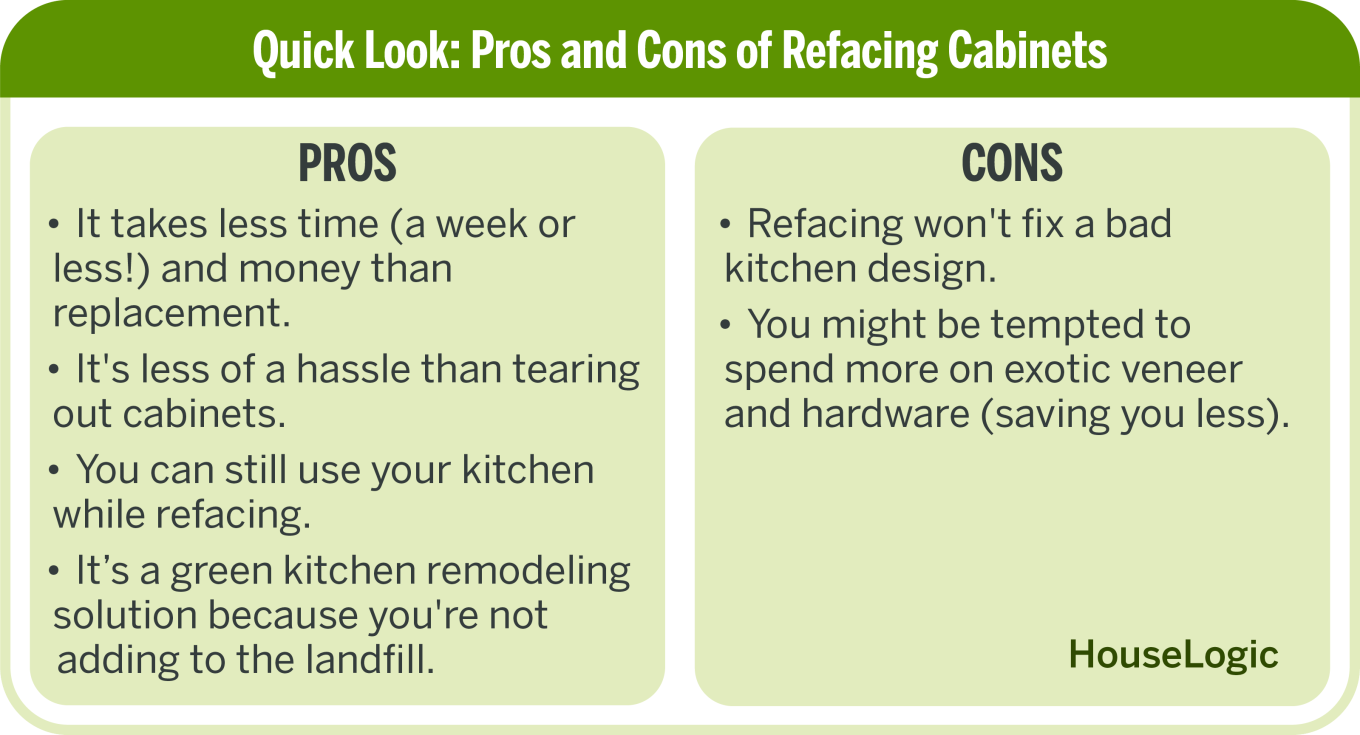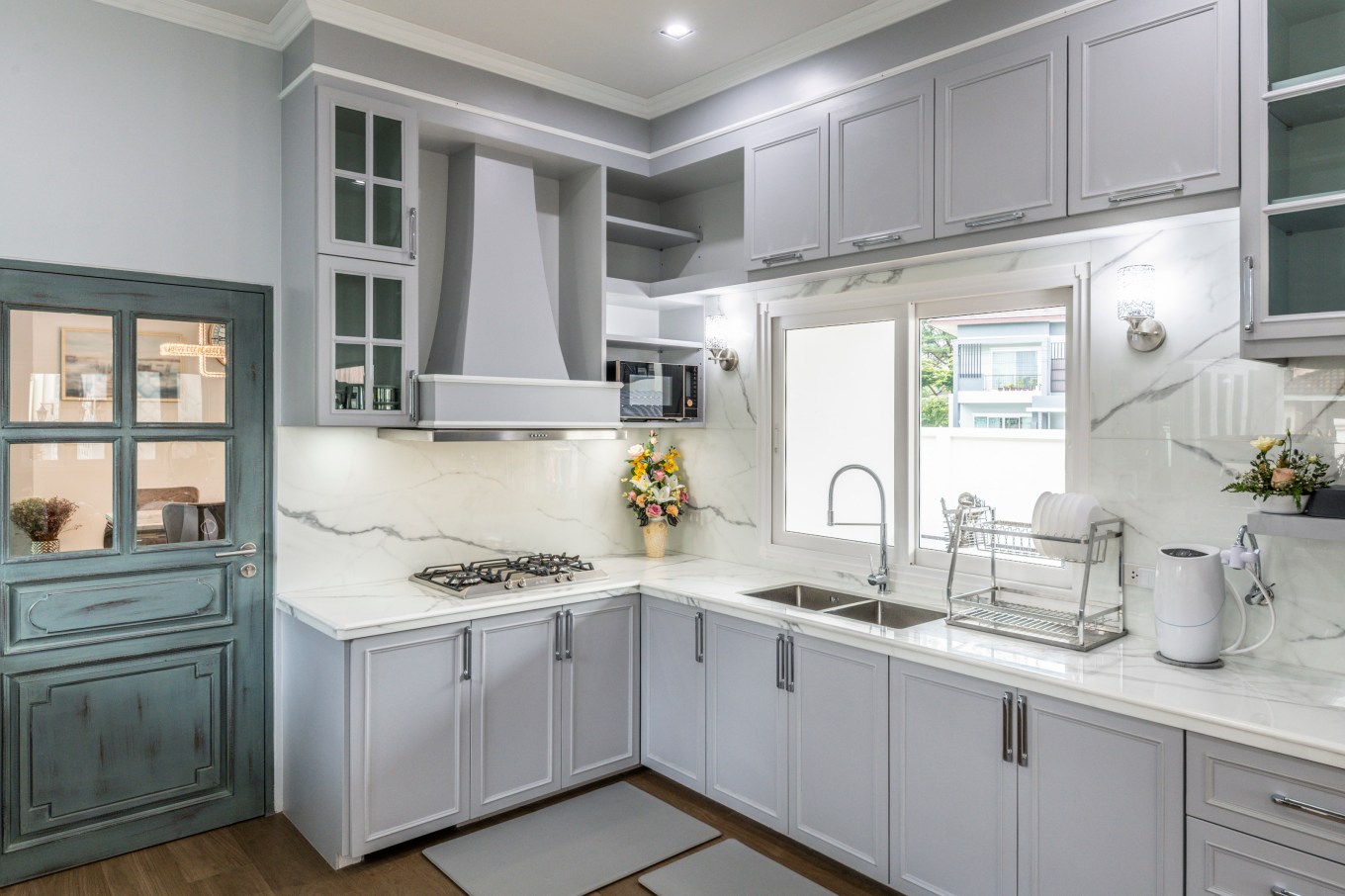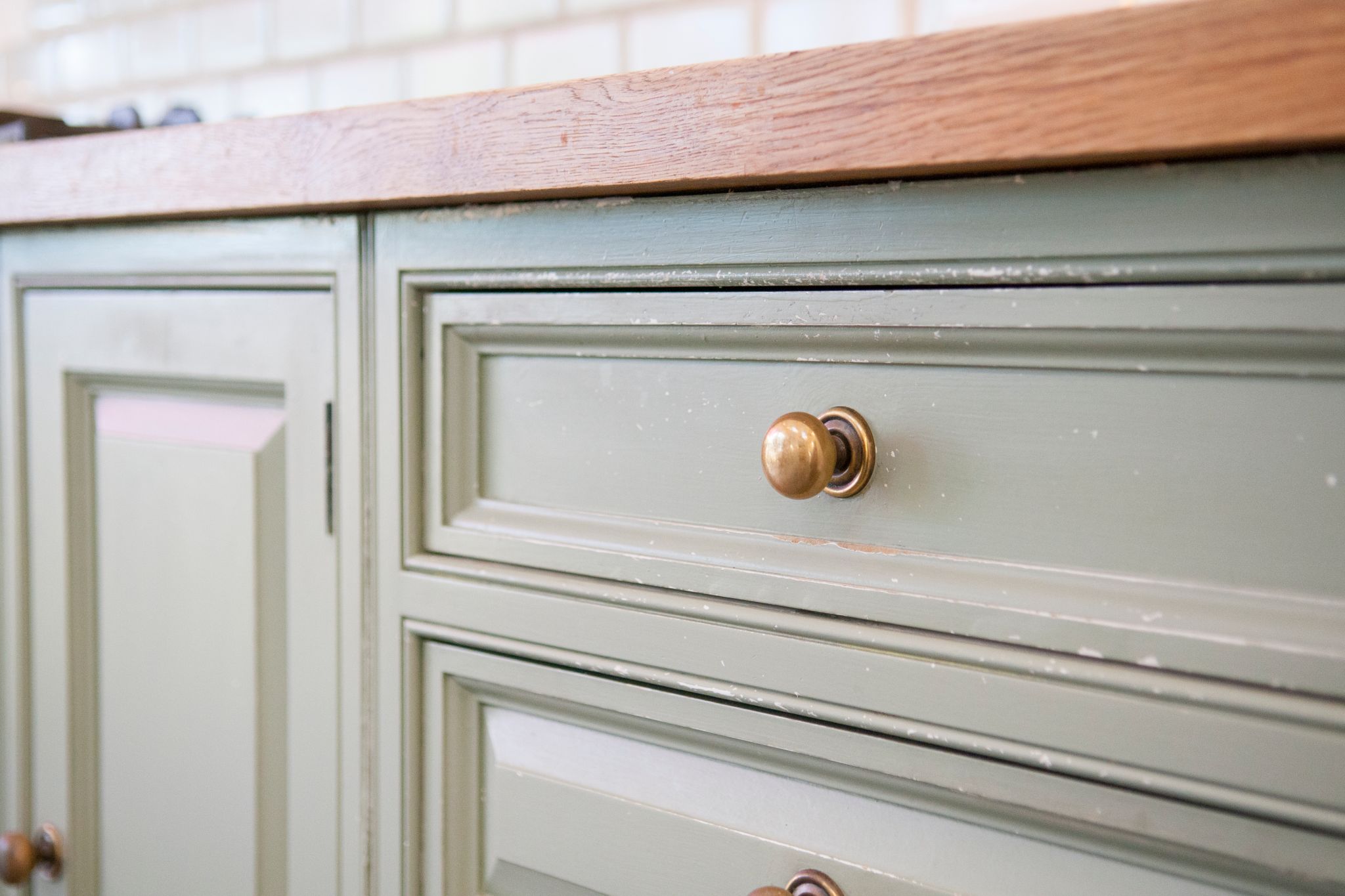Tired or dated-looking kitchen cabinets can be an eyesore in your kitchen — and even be a drawback when you're ready to sell your home. The 2022 Remodeling Impact Report from the National Association of REALTORS® estimated that survey respondents would recover around 67% of the value of their kitchen upgrades when they sold their home.
If you're thinking of transforming your cabinets, you have a couple of options: reface them or replace them. Either option makes sense in certain circumstances, but the cost, disruption, and your expectations will vary substantially depending on which you choose.
What Are the Steps in Refacing a Kitchen Cabinet?
With refacing, you'll cover the exposed frames with a thin veneer of real wood or plastic laminate. To match or complement the new veneer, you’ll replace doors and drawer fronts. Then you’ll add new hinges, knobs, pulls, and molding to complete the transformation.
What Are the Pros and Cons of Refacing?

Kitchen cabinet refacing pros:
- It takes less time (a week or less!) and money than replacement.
- It's less of a hassle than tearing out cabinets.
- You can still use your kitchen while refacing.
- It’s a green kitchen remodeling solution because you're not adding to the landfill.
Kitchen cabinet refacing cons (there aren't many):
- Refacing won't fix a bad kitchen design.
- You might be tempted to spend more on exotic veneer and hardware (saving you less).
What Are Your Cabinet Refacing Options?
Your choices for the finished look of your cabinets are extensive. Veneers are available in a wide variety of colors, patterns, textures, and grains, which you can mix or match to get a relatively low-cost kitchen facelift.
- Rigid thermofoil doors, which feature a durable plastic coating over fiberboard, are an affordable alternative to wood or laminate doors.
- Plastic laminates come in hundreds of colors and patterns, are durable and moisture-resistant, and are reasonably priced. You can pick matching or contrasting laminates for your doors and drawer fronts.
- Real wood veneers include many standard species, such as oak, cherry, and maple, and you can also choose from an array of stain colors. Wood veneers are the most expensive option, and you have to carefully seal the wood to protect against moisture.
Further customize and update the look of your cabinets with new kitchen cabinet hardware.
How to Reface Your Kitchen Cabinets
It all starts with determining what type of refacing you have in mind. Evaluate your skill level, budget, and project timeline to determine the best path for you and whether you can DIY this project or should hire a pro.

Refacing Cabinets with Veneer
If you trust your measuring and cutting skills, covering your cabinets with wood/laminate veneers can be a great option. For homeowners with previous carpentry experience, this method can produce quality results.
- Remove the cabinet doors and drawers, then thoroughly clean and dry all the surfaces.
- Cut your peel-and-stick veneers to the right size and affix them to your cabinets.
- Use a wooden block to press down on the veneer and smooth out any air bubbles.
Paint or Refinish Your Cabinets
If you love your cabinets but want a color update, consider painting or staining. Staining requires sanding down the cabinet doors which can be a messy and time-consuming process. Consider painting without sanding for a quicker result.
What Does Refacing Cost?
A professional cabinet refacing for a typical 10-foot-by-12-foot kitchen starts at about $100 per linear foot for laminate materials only. Expect to pay more, $200 per linear foot, for wood veneer materials. Hardwood will run about $455 per linear foot without installation.
Finishing the project with new hardware (pulls and knobs) runs $100 to $1,000 per cabinet, with handles costing about $1 to $100 per piece and hinges selling for $1 to $25 per piece.
What Does Replacing Cost?
In comparison, replacing old kitchen cabinets with new ones, and excluding installation, costs about:
- $100 to $700 per linear foot for semi-custom or stock cabinets
- $500 to $1,200 per unit for custom cabinets, including installation
How Do I Know If My Cabinets Are Good for Refacing?
Refacing is feasible if your existing cabinet boxes are structurally sound and in good condition. Cabinets with water damage, warping, or broken frames are poor candidates. Particleboard cabinetry sometimes requires fasteners, in addition to adhesives, to secure the veneer.
How Is Veneer Installed?
A professional installer will come to your house to measure your cabinets and determine the amount of veneer required, the correct sizes and quantities for door and drawer fronts, and the amount of hardware needed.
When all the materials are in hand, your installer will remove the old cabinet door and drawer fronts, and prepare the surfaces of the cabinet boxes by washing the exteriors with a degreaser and lightly sanding the finish. Any significant flaws in the surface will be repaired or filled to createe a smooth, secure fit for the new veneer. The installer will apply veneer to the cabinet faces and any exposed cabinet ends, then mount the new doors, drawer fronts, and hardware. The process typically takes two to four days.
The installer will apply veneer to the cabinet faces and any exposed cabinet ends, then mount the new doors, drawer fronts, and hardware. The process typically takes two to four days.
If you've been wanting a cabinet refresh, you have choices based on your budget, time frame, tolerance for disruption, and the level of change you want. Whichever choice you make, your updated cabinets will put a fresh face on your kitchen.
Cabinet Refacing FAQs

Is It a Good Idea to Reface Kitchen Cabinets?
Refacing your kitchen cabinets can work well if the cabinets are sturdy and in good condition. Refacing allows you to refresh the look of a space without a comprehensive cabinet overhaul.
What Does Cabinet Refacing Include?
Cabinet refacing may include applying new veneers on existing cabinets, changing the hardware (handles and hinges), sanding and staining or painting, or replacing your cabinet doors and drawers altogether. It’s up to you to determine which changes you want to make and which elements of your cabinets you want to retain.
How Long Does Cabinet Refacing Last?
As with most construction work, the quality of materials and labor can make a big difference. High quality materials paired with skilled and experienced labor can result in cabinets that last a decade or two. Poor workmanship or materials may mean your veneers come loose or start showing signs of wear in a year or two. It’s worthwhile to invest in the highest qualitygood materials you can afford and an experienced team when you can.
